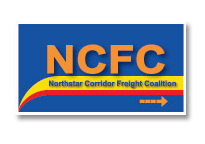CCFC's Public Sector Partner, Anticipated Recommendation.
Fri, 10/15/2004The Upper Midwest Freight Corridor Study will be set for release to the public by year end 2004. CCFC counsel attended the final workshop on the Upper Midwest Freight Corridor Study, August 10-11, at Chicago. Follow-up confirms that final work, review and release of the Study are on schedule. Since late 2002, these workshops and advisory committee meetings have served as a forum for looking at freight from a regional perspective. Consistent with CCFC's objective, the participants made a clear commitment to taking specific steps to create an on-going regional public sector group. The commitment and specific steps are based on a lengthly list of issues on which consensus emerged, including:
- On-going Public Sector Group. Working together as a region on freight issues could create a larger pool of [public transportation] resources for our region, being used more efficiently. This would give our region a competitive advantage relative to other regions of the nation and the world. Working together can also help the region interact more constructively with the larger stakeholders in freight transportation.
- Importance of Intra-Regional Freight Movements. Although freight movements that only pass through the region are [a significant burden and cost on the corridor], participants were surprised to see [data documenting] the importance and quantity of intra-regional shipments. We, in the region, are our own best trading partners.
- Relationship of Freight and Passengers. Improvements for freight are almost always good for passengers, but not necessarily vice versa.
- Immediate Steps To Promote the Effort. The [public sector] steering committee will work to move forward on corridor efforts [in presentations to the Chief Administrative Officers of the States of the region] at the national AASHTO meeting [in September]. The [public sector corridor] effort should get an official name [other than Upper Midwest Freight Corridor “Study”]. There should be an official [public sector] coalition structure, [possible organization into] policy and technical committees [was] suggested.
Among specific, proposed, substantive action items are the following:
- Foundation for Attracting Federal Funding. Take the necessary actions to get the corridor designated as a “Corridor of National Significance” (i.e., it provides opportunity to access federal funding, as have other regional corridor efforts).
- Attracting Federal Funds for Pilot Projects. Offer Federal Highway Administration Freight Office support of the region to use the [Central Corridors] as a “new initiatives corridor” or “test case studies corridor”.
- Regionally Focused Review of Federal Reauthorization. Review various versions of reauthorization to identify provisions that would benefit the corridor. Provide a “white paper” with advice and reasoning to [each State's] AASHTO representatives as to what they should advocate relative to freight (i.e., providing a foundation for improving voluntary cooperation and coordination among the States of the region). Talk with the FHWA Freight Office to try to find out what will most likely be the freight provisions in the new bill. Provide the background research so that the states along the corridor can hit the ground running (i.e., to access federal funds for freight projects, e.g., how to deal with a possible 2% set-aside for improvements in National Highway System segments that are “intermodal connectors”).
- Identification of Choke Points and Bottlenecks. Coordinating with the State DOTs, identify a list of specific choke points and problem locations that need to be addressed to help the overall flow. Identify what projects are needed for the benefit of the entire corridor (i.e., provide system synergies).
- Communications Materials. Prepare a brochure (colorful, short, easy to read) that all States and stakeholders can take and use as an education piece on the importance of the corridor and working together to improve it.
- Communications and Networking. Network with the States' AASHTO representatives and FHWA's Freight Office for support and co-sponsorship of the corridor [public sector coalition] and the recommendations of the [Upper Midwest Freight Corridor Study]. Present them with the findings of the Study. Ask for their advice and directions for next steps.
These and other consensus items, as well as the specific proposed actions, confirm the value of commitment to participation in the efforts of the Upper Midwest Freight Corridor Study and Midwest Regional University Transportation Center to promote “Looking at Freight From a Regional Perspective”. Delivery of results from this effort is equally dependent on CCFC's mobilization of the private sector stakeholders of the region to complement and capitalize on this public sector effort.



